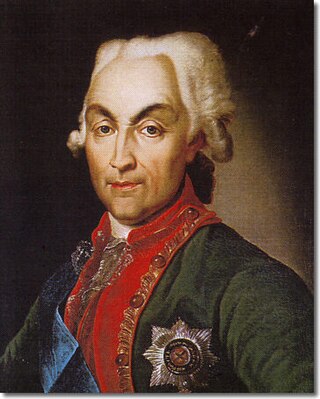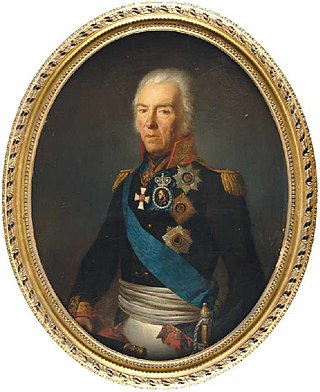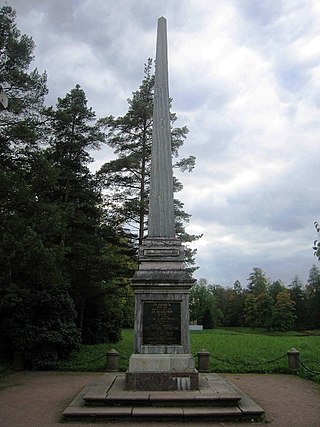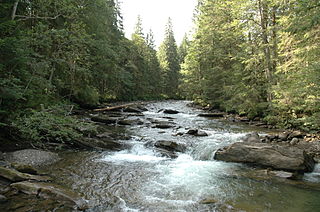
Prince Mikhail Illarionovich Golenishchev-Kutuzov-Smolensky was a Field Marshal of the Russian Empire. He served as a military officer and a diplomat under the reign of three Romanov monarchs: Empress Catherine II, and Emperors Paul I and Alexander I. Kutuzov was shot in the head twice while fighting the Turks and survived the serious injuries seemingly against all odds. He defeated Napoleon as commander-in-chief using attrition warfare in the Patriotic war of 1812. Alexander I, the incumbent Tsar during Napoleon's invasion, would write that he would be remembered amongst Europe's most famous commanders and that Russia would never forget his worthiness.

Count Alexander Vasilyevich Suvorov-Rymniksky, Prince of Italy, was a Russian general and military theorist in service of the Russian Empire and the Habsburg monarchy. He was Count of Rymnik (1789), Graf of the Holy Roman Empire (1789), Feldmarschall of the Holy Roman Empire (1799), Prince of the Kingdom of Sardinia (1799), Grand marshal of the Kingdom of Sardinia (1799), Prince or Knyaz of the Russian Empire (1799), Field marshal (1794) and the last Generalissimo (1799) of the Russian Empire. Suvorov is considered one of the greatest military commanders in Russian history and one of the great generals of the early modern period. He was awarded numerous medals, titles, and honors by Russia, as well as by other countries. Suvorov secured Russia's expanded borders and renewed military prestige and left a legacy of theories on warfare. He was the author of several military manuals, the most famous being The Science of Victory, and was noted for several of his sayings. He never lost a single battle he commanded, and his military record is extensive; Suvorov won in a total of 63 battles without suffering a major defeat. He raised Russian military glory to a height to which it had never reached. Several military academies, monuments, villages, museums, and orders in Russia are dedicated to him.

The Battle of Tendra was a naval action fought on 8 and 9 September 1790 in the Black Sea as part of the Russo-Turkish War (1787–1792). It ended in a decisive victory for the Russians over the Ottomans.

Prince Nikolai or Nicholas Vasilyevich Repnin was a Russian statesman and general from the Repnin princely family who played a key role in the dissolution of the Polish–Lithuanian Commonwealth.

Russo-Turkish wars or Russo-Ottoman wars were a series of twelve wars fought between the Russian Empire and the Ottoman Empire between the 16th and 20th centuries. It was one of the longest series of military conflicts in European history. Except for the war of 1710–11, as well as the Crimean War which is often treated as a separate event, the conflicts ended disastrously for the Ottoman Empire, which was undergoing a long period of stagnation and decline; conversely, they showcased the ascendancy of Russia as a European power after the modernization efforts of Peter the Great in the early 18th century.

The Battle of Akhaltsikhe during the Russo-Turkish War, 1828–1829, may refer to one of the following. Firstly, an offensive battle under the walls of Akhaltsikhe on August 21, 1828, between 9,000 Russians under Field-Marshal Paskevich on the offensive and 30,000 Turks under Kios-Mahomet-Pasha. The Russians were victorious. They then successfully stormed the Akhaltsikhe Castle. Secondly, a successful Russian defense of the same fortress by a garrison under General Nicholas Muravyov from a 20,000 Turkish force under Ahmed-Bey on March 3–16, 1829, during the same conflict.

Count Pyotr Alexandrovich Rumyantsev-Zadunaisky was one of the foremost Russian generals of the 18th century, and one of the great military commanders in universal history between 1618 and 1905. Rumyantsev used mobile divisional squares for the first time in history as opposed to linear battle orders and initiated the formation of light (jaeger) battalions in the Russian Army, which operated in a scattered order.

Count Ivan Vasilyevich Gudovich was a Russian noble and military leader of Ukrainian descent. His exploits included the capture of Khadjibey (1789) and the conquest of maritime Dagestan (1807).

The Battle of Kagul or Cahul occurred on 1 August 1770 during the Russo-Turkish War of 1768–1774. It was the decisive and most important land battle of the war and one of the largest battles of the 18th century. It was fought in Moldavia, near the village of Frumoasa, nearly a month after the Russian victory at Larga.

The Kagul Obelisk in Tsarskoye Selo is one of several such structures erected on behest of Catherine II of Russia in 1772 to commemorate Pyotr Rumyantsev's victory in the Battle of Kagul. Designed by Antonio Rinaldi, the dark grey-and-red marble obelisk stands in the landscape park of the Catherine Palace.

The Battle of Rymnik or Rimnik, also Battle of Mărtinești, on September 22 [O.S. September 11] 1789, took place in Wallachia, at the Râmnicul Sărat River, known as the Rymnik, near Râmnicu Sărat or Rymnik during the Russo-Turkish War of 1787–1792 and the Austro-Turkish War of 1788–1791. The Russian general Alexander Suvorov, acting together with the Habsburg general Prince Josias of Coburg, attacked the main Ottoman army under Grand Vizier Cenaze Hasan Pasha. The result was a crushing Russo-Austrian victory. Although this battle was fought in accordance with Suvorov's intentions, the Austrians made up the bulk of the victorious allied troops.

Count, then Prince Nikolay Ivanovich Saltykov, a member of the Saltykov noble family, was a Russian Imperial Field Marshal and courtier best known as the tutor of the eventual Tsar Paul I of Russia and his two sons, Constantine and Alexander.

The Battle of Măcin, Battle of Maçin, Battle of Matchin or Battle of Matschin took place during the Russo-Turkish War (1787–1792), fought on 9 July 1791 between the Ottoman Empire and the Russian Empire. The Russian army of 30,000 was commanded by Prince Nicholas Repnin, whereas the Turks, numbering about 80,000 men, were led by Koca Yusuf Pasha.

Johann Hermann von Fersen was a Saxon-born infantry general who served from 1770 in the Imperial Russian Army.

Alexander Mikhailovich Golitsyn was a Russian prince of the House of Golitsyn and field marshal. He was the General Governor of Saint Petersburg Governorate in 1780 to 1783.

The Prut is a 953 km (592 mi) long river in Eastern Europe. It is a left tributary of the Danube. Part of its course forms Romania's border with Moldova and Ukraine.
The Second Battle of Zrínyiújvár was fought on November 27, 1663, as part of the Austro-Turkish War (1663–1664), between the Kingdom of Hungary and the Kingdom of Croatia under the command of Ban Miklós Zrínyi and an Ottoman army. The battle took place near Zrínyiújvár in present-day Croatia and was a Hungarian-Croatian victory.
Prince Rodion (Radukan) Matveyevich Cantacuzino was a Wallachian colonel, a participant of the Russo-Turkish War of 1768–1774. The founder of the Russian branch of the Wallachian Cantacuzino family.

Events in the year 1770 in Russia

Fyodor Ivanovich Glebov was a general-in-chief under Catherine the Great in 1782, a senator in 1781, and he built the Znamenskoye-Rayok Estate. He was one of the highest-ranking and richest members of the Glebov family.


















